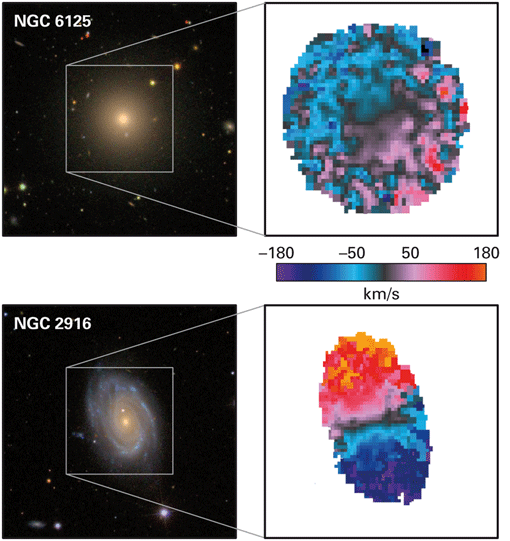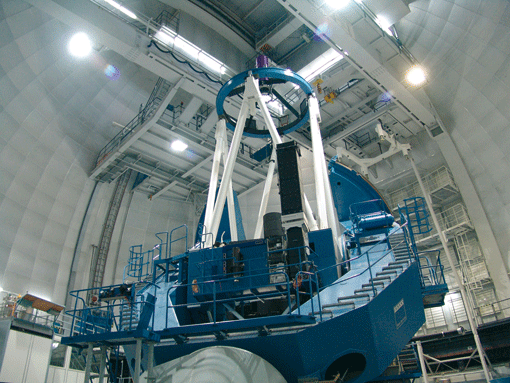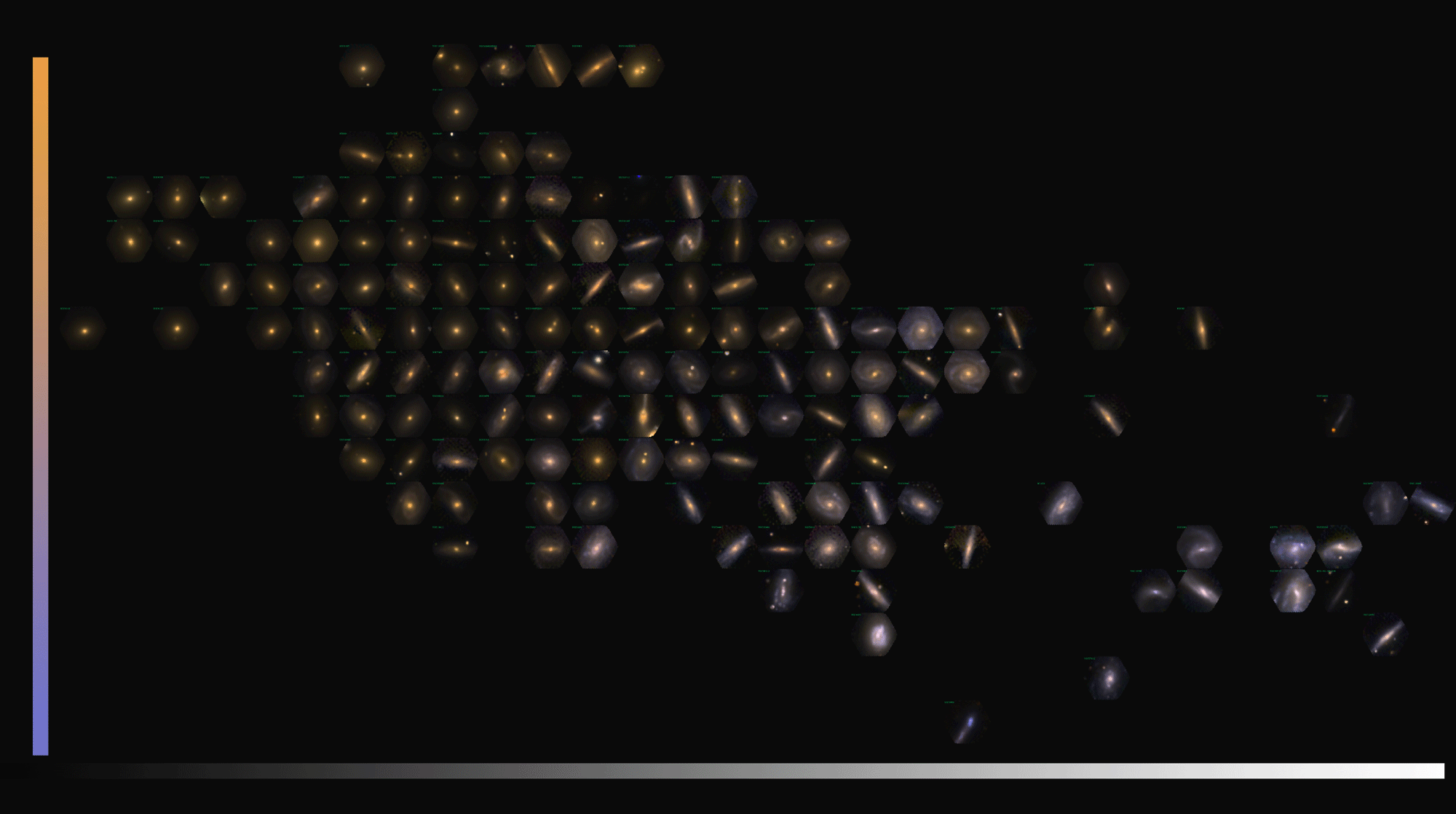|
|
MPIA Science Release 2012-10-31 |
|
| German version |
CALIFA survey publishes intimate details of 100 galaxies
The Calar Alto Legacy Integral Field Area survey (CALIFA survey) has published a first set of data, offering views of one hundred galaxies in the local Universe at an unprecedented level of detail. The new data represent the first large-scale effort at "two plus one" mapping of galaxies: for every pixel within each two-dimensional image, a detailed ("spectral") analysis can be performed, providing information about dynamics and chemical composition. These, in turn, yield key information that will allow scientists to reconstruct the structure and dynamics of galaxies, as well as their evolution over time.
| Figure 1: The CALIFA Survey will provide detailed information about 600 galaxies in the local Universe. This image shows two examples: The quiescent elliptical galaxy NGC 6125 (top) and the spiral galaxy NGC 2916, in which stars are still forming (bottom). For each galaxy, an image taken by an earlier survey (SDSS) is seen on the left. The image on the right shows CALIFA data about whether or not that part of the galaxy is moving towards us (blueish colors) or away from us (reddish colors). The elliptical galaxy is rotating very gently. In the spiral galaxy, on the other hand, the stars rotate with speeds of up to 180 kilometres per second or more. Image credit: CALIFA-Team / M. Lyubenova (MPIA) |
 [Larger version for download] |
| Contact | Background information | Links | Images |
Galaxies are the large-scale building blocks of the cosmos. Their visible ingredients include between millions and hundreds of billions of stars as well as clouds of gas and dust. "Understanding the dynamical processes within and between galaxies that have shaped the way they are today is a key part of understanding our wider cosmic environment.", explains Dr. Glenn van de Ven, a member of the managing board of the CALIFA survey and staff scientist at the Max Planck Institute for Astronomy (MPIA).
Traditionally, when it came to galaxies, astronomers had to choose between different observational techniques. They could, for instance, take detailed images with astronomical cameras showing the various features of a galaxy as well as their spatial relations, but they could not at the same time perform detailed analyses of the galaxy's light, that is "obtain a galaxy spectrum". Taking spectra required a different kind of instrument known as a spectrograph, which, as a downside, would only provide very limited information about the galaxy's spatial structure.
An increasingly popular observational technique, integral field spectroscopy (IFS), combines the best of both worlds. The IFS instrument PMAS mounted at the Calar Alto Observatory's 3.5 metre telescope uses 350 optical fibres to guide light from a corresponding number of different regions of a galaxy image into a spectrograph. In this way, astronomers are not restricted to analysing the galaxy as a whole – they can analyse the light coming from many different specific parts of a galaxy. The result are detailed maps of galaxy properties such as their chemical composition, and of the motions of their stars and their gas.
For the CALIFA survey, more than 900 galaxies in the local Universe, namely at distances between 70 and 400 million light years from the Milky Way, were selected from the northern sky to fully fit into the field-of-view of PMAS. They include all possible types, from roundish elliptical to majestic spiral galaxies, similar to our own Milky Way and the Andromeda galaxy. The allocated observation time will allow for around 600 of the pre-selected galaxies to be observed in depth.
The resulting data could revolutionize astronomers' understanding of galactic dynamics. Dr. Knud Jahnke, one of the co-founding members of the CALIFA project, is excited about one possibility in particular: "Large amounts of gas in these galaxies are being ionized – intense radiation is stripping the gas's atoms of electrons. CALIFA allows us to study these processes in unprecedented detail." With surprising consequences, as graduate student Robert Singh adds: "For the past 30 years, astronomers thought they understood the origin of this ionizing radiation. But our initial analysis strongly suggests that the standard paradigm is wrong."
"Even the mysterious dark matter in these galaxies can no longer evade detection", adds Dr. Mariya Lyubenova, a postdoctoral research fellow at MPIA. Dark matter accounts for roughly 20% of the total energy content of the Universe, but its exact distribution within distant galaxies is difficult to determine. However, whereas dark matter cannot be seen directly, its gravitational attraction influences the motions of a galaxy's stars and gas. CALIFA will be able to track these motions with great precision, allowing the galaxy's dark matter distribution to be uncovered.
It is important to note that CALIFA is a legacy survey: all of its data will become freely available online to be used by scientists world-wide. The data on an initial set of 100 galaxies are now being released. CALIFA is the first IFS study to be explicitly designed as a legacy project and, upon completion, it will be the largest survey of this kind ever accomplished.
| top |
Contact information
Glenn van de Ven (member, CALIFA managing board)
Max Planck Institute for Astronomy
Heidelberg, Germany
Phone: (+49|0) 6221 – 528 275
Email: glenn@mpia.de
Knud Jahnke (co-founding member, CALIFA)
Max Planck Institute for Astronomy
Heidelberg, Germany
Phone: (+49|0) 6221 – 528 398
Email: jahnke@mpia.de
Markus Pössel (Public relations)
Max Planck Institute for Astronomy
Heidelberg, Germany
Phone: (+49|0) 6221 – 528 261
Email: pr@mpia.de
| top |
Background information
Calar Alto Observatory was founded in 1979 and is located in Andalusia, Spain. It is operated jointly by the Max Planck Institute for Astronomy (MPIA) and the Astrophysical Institute of Andalusia (IAA-CSIC, Granada, Spain). The Observatory has granted 250 observing nights over the course of three years, using the 3.5 metre telescope for the CALIFA survey. This project is a joint effort of more than 80 scientists from 25 different research institutes in 13 different countries world wide.
The integral field spectrograph used for the CALIFA survey at Calar Alto Observatory, PMAS (in a special configuration called PPAK), uses more than 350 optical fibres to cover a field of view of one square arcminute (equivalent to the apparent size of a 1 euro coin placed at a distance of approximately 80 metres). This allows a complete extended object, such as a galaxy, to be fully mapped in detail in just one exposure.
For the CALIFA survey, care has been taken to select the possible observation targets at random from the overall population of galaxies. In that way, the galaxies under study should be representative of the whole: Statistical conclusions from the analysis of their data should thus allow astronomers to draw conclusions about local galaxies in general.
The CALIFA member institutions are: Astrophysical Institute, Academy of Sciences of the Czech Republic, Prague; Australian Astronomical Observatory, Australia; Centro Astronómico Hispano Alemán, Spain; Centro de Astrofísica da Universidade do Porto, Portugal; Institut d'Astrophysique de Paris, France; Instituto de Astrofisica de Andalucia, Spain; Instituto de Astrofisica de Canarias, Spain; Instituto de Física de Cantabria, Spain; Laboratoire d'Astrophysique de Marseille, France; Leibniz Institut für Astrophysik, Potsdam, Germany; Max Planck Institute for Astronomy, Heidelberg, Germany; Observatoire de Paris, France; Peking University – Kavli Institute for Astronomy and Astrophysics, China; Royal Military College of Canada, Canada; Tianjin Normal University, China; Universidad Autónoma de Madrid, Spain; Universidad de Complutense de Madrid, Spain; Universidad de Granada, Spain; Universidad de Zaragoza, Spain; University of Bochum, Germany; University of Cambridge, UK; University of Copenhagen – Dark Cosmology Centre, Denmark; University of Edingurgh, UK; University of Groningen – Kapteyn Astronomical Institute, The Netherlands; University of Heidelberg – Landessternwarte Königstuhl, Germany; University of Lisbon, Portugal; University of Missouri-Kansas City, USA; University of Porto, Portugal; University of Sidney, Australia; University of Vienna, Austria.
| top |
Links
- CALIFA home page
- CALIFA First Data Release
- Calar Alto Observatory
- PMAS home page
- The Zeiss 3.5 m reflector at Calar Alto:
Data: http://www.caha.es/CAHA/Telescopes/3.5m.html
With PMAS: http://www.caha.es/images/stories/PR_2/Sandin/tel35m_pmas_english.jpg - Previous Calar Alto press release on CALIFA:
http://www.caha.es/the-califa-project-starts-up.html
| top |
 |
||
Figure 2: The 3.5 m Zeiss reflector at Calar Alto Observatory, which was used for the CALIFA observations. Image credit: MPIA [Larger version for download] |
||

| ||
Figure 3: The 3.5 m Zeiss reflector at Calar Alto Observatory, with the PMAS spectrograph used for the CALIFA survey attached Image credit: CAO / Santos Pedraz [Larger version for download] |
||
 |
||
Figure 4: This colour-magnitude diagram of 151 galaxies observed by CALIFA arranges galaxies by their colour and their brightness (magnitude). For each galaxy a true-color image is shown, created using the B (blue), V (green) and R (red) band reconstructed images extracted from the CALIFA data cubes. Colour indicates whether many or few new stars are currently being formed in a galaxy, whereas the brightness is a rough measure of the number of stars in the galaxy. In this diagram, the galaxies get fainter towards the left and brighter towards the right, while they are redder (inactive; fewer new stars forming) at the top, and bluer (active; numerous new stars forming) towards the bottom of the image. An example of the scientific results that can be obtained from CALIFA data: A stack of maps of one galaxy (NGC 5406) displaying the spatial distribution of several properties; from top down: emission from ionized hydrogen, velocity of the gas inside the galaxy, estimated age of the stellar population, and brightness in the visual band. Image credit: CALIFA-Team [Larger version for download] |
| top |
Images
 |
PR_121101_1.png | JPG | RGB | 510 x 547 pxl 72 dpi |
86 KB |
| PR121031_1gr.png | JPG | RGB | 1200 x 1273 pxl 72 dpi |
385 KB | |
| PR121031_1.pdf | CMYK | – | 3,6 MB | ||
 |
PR_121101_2.png | JPG | RGB | 510 x 383 pxl 72 dpi |
133 KB |
| PR121031_2gr.png | JPG | RGB | 1200 x 900pxl 72 dpi |
675 KB | |
| PR121031_2hr.png | JPG | RGB | 1417 x 1063 pxl 72 dpi |
934 KB | |
 |
PR_121101_3.png | PNG | RGB | 510 x 366 pxl 72 dpi |
111 KB |
| PR_121101_3gr.png | PNG | RGB | 1200 x 862pxl 72 dpi |
535 KB | |
| PR_121101_3hr.png | PNG | RGB | 2000 x 1437 pxl 72 dpi |
1,32 MB | |
 |
PR_121101_4.png | JPG | RGB | 2000 x 1118 72 dpi |
295 KB |
| PR121031_4gr.png | JPG | RGB | 4000 x 2236 pxl 72 dpi |
975 KB | |
| PR121031_4hr.jpg | JPG | RGB | 9387 x 5247 pxl 72 dpi |
2,7 MB | |
Press Releases 2012